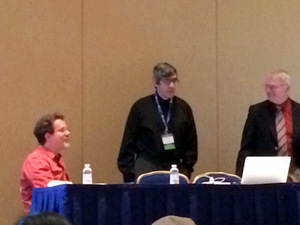
Mathematics Events at the 2016 AAAS Meeting
The 2016 annual meeting of the American Association for the Advancement of Science (AAAS) took place in Washington, DC February 11-15. About 9,000 people attended the meeting, including those who attended Family Science Days on the weekend. Below are brief descriptions of some of the mathematics-related symposia as well as a slideshow of photos from the meeting.
Partnering with Africa through Applied Mathematics

(Left to right: Zomahoun, Hermi, Frederick, and discussant Wayne Patterson of Howard University.) |
This symposium was organized by Evans Harrell of the Georgia Institute of Technology, who also organized a team (Harrell, Christina Frederick, and Stephen Malone) that visited two institutes in West Africa and participated in workshops there. Frederick talked about the visits to the African Institute of Mathematical Sciences (AIMS) in Senegal (one of five such centers) and L'Institut de Mathématiques et de Sciences Physiques in Benin. The worskhops helped establish connections with African mathematicians and scientists that has led to projects modeling the tropical disease schistosomiasis and modeling geological phenomena. |
Lotfi Hermi, University of Arizona, spoke about the rich scientific history of Tunisia and the current huge unemployment among college graduates there. Thierry Zomahoun, of AIMS and the Next Einstein Initiative, explained his work and the work AIMS does training mathematicians, scientists, and engineers, as well as recent training of math teachers. He pointed out that there are more African scientists and engineers in the U.S. than in Africa.
Mathematics and Music

Left to right: Dmitri Tymoczko, Noam Elkies, and David Wright before the start of the symposium. |
A big crowd listened to three talks on different facets of the connections between math and music. Noam Elkies, Harvard University, began the symposium by addressing the question of how many pieces of music there are. He explained that he was not seeking an exact number and was not considering every possible arrangement of notes, since most arrangements aren't what people would call music. He gave a lower bound of 104 different measures, so that, for example, there are at least 10800 possible pieces of length 200 measures. Elkies finished his talk by playing his 61-measure "Steganographic Étude #1" based on the first 244 digits of pi and added that memorizing the music helped him memorize those digits of pi. During the Q&A, he estimated that there are fewer than a million pieces of music that have been created. |
Dmitri Tymoczko, Princeton University, explained how vectors and topology could help understand music. He noted that his study of composers has shown that how Bach's music, for example, moved along a path from one chord to another is different than what is presented in music theory books. David Wright of Washington University introduced the ratios between notes and talked about the difference between the true intervals associated with notes and the intervals on a piano.
Massively Collaborative Global Research in Mathematics and Science
 |
Edward Aboufadel (pictured) of Grand Valley State University organized this symposium, which took place on the last morning of the meeting. The second and third talks focused on mathematics. Andrew Sutherland of MIT talked about the collaborative Polymath Project on bounded gaps between prime numbers. He gave the audience a background on prime numbers and their distribution, and explained how that Polymath project, Polymath 8, worked, based on his experience and contributions to the project. Alison Pease, University of Dundee (Scotland), and her team are using the rich and precise data associated with online collaborations to study how mathematics is done. |
AMS Exhibit
 |
AMS Public Awareness Officer Annette Emerson (pictured) and Assistant Director of the AMS Washington Office Anita Benjamin staffed the AMS exhibit, which featured the 2016 Calendar of Mathematical Imagery, Mathematical Moments--a series of over 120 posters that promotes appreciation of the role mathematics plays in science, nature, technology and human culture--the Mathematics and Music poster, a Powered by Math poster, and selected AMS books. Visitors to the exhibit included mathematicians, scientists from many disciplines, press, teachers, and Family Days participants. |
Here's a slideshow of photos of the symposia and booth.

The 2017 AAAS annual meeting will be in Boston (MA), February 16-20. The AAAS website has more information.
You can also read about mathematics at previous AAAS meetings: 2015, 2014, 2013, 2012, 2011, 2010, 2009, 2008, 2007, 2006, 2005, 2004, 2003, and 2002.
Text and photos by AMS Public Awareness Officer Mike Breen.

